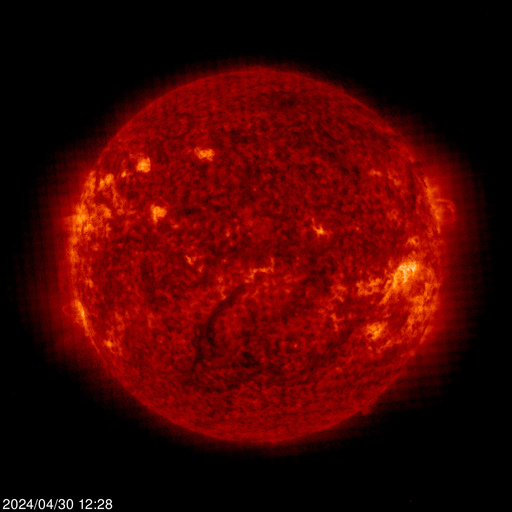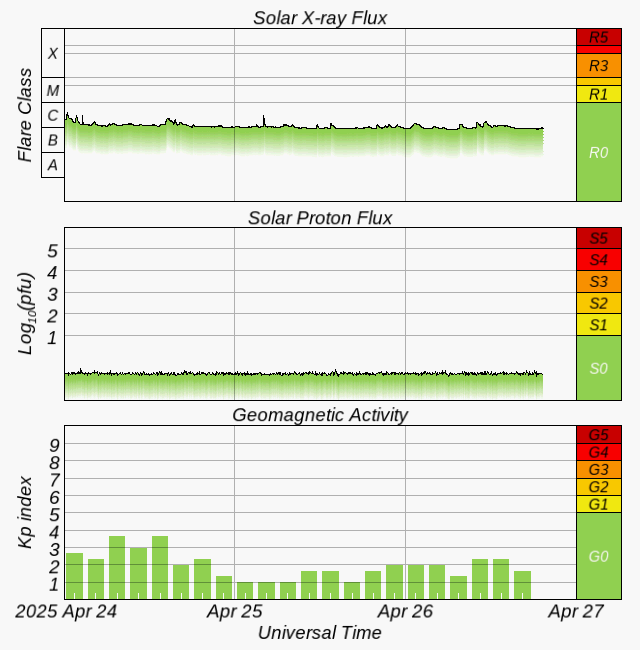Space Weather
3-day Solar-Geophysical Forecast
Product: 3-Day Forecast
- Issued: 2025 Nov 19 1230 UTC
Prepared by the U.S. Dept. of Commerce, NOAA, Space Weather Prediction Center.
Geomagnetic Activity Observation and Forecast
The greatest observed 3 hr Kp over the past 24 hours was 1 (below NOAA Scale levels). The greatest expected 3 hr Kp for Nov 19-Nov 21 2025 is 4.00 (below NOAA Scale levels).
| Nov 19 | Nov 20 | Nov 21 | |
|---|---|---|---|
| 00-03UT | 0.67 | 1.67 | 2.00 |
| 03-06UT | 0.33 | 1.33 | 1.33 |
| 06-09UT | 1.00 | 1.33 | 1.33 |
| 09-12UT | 0.67 | 1.33 | 2.00 |
| 12-15UT | 1.33 | 1.33 | 2.33 |
| 15-18UT | 1.33 | 1.33 | 3.00 |
| 18-21UT | 1.67 | 1.67 | 3.33 |
| 21-00UT | 1.67 | 1.67 | 4.00 |
Rationale: No G1 (Minor) or greater geomagnetic storms are expected. No significant transient or recurrent solar wind features are forecast.
Solar Radiation Activity Observation and Forecast
Solar radiation, as observed by NOAA GOES-18 over the past 24 hours, was below S-scale storm level thresholds.
| Nov 19 | Nov 20 | Nov 21 | |
|---|---|---|---|
| S1 or greater | 1% | 1% | 1% |
Rationale: No S1 (Minor) or greater solar radiation storms are expected. No significant active region activity favorable for radiation storm production is forecast.
Radio Blackout Activity and Forecast
No radio blackouts were observed over the past 24 hours.
| Nov 19 | Nov 20 | Nov 21 | |
|---|---|---|---|
| R1-R2 | 15% | 15% | 15% |
| R3 or greater | 1% | 1% | 1% |
Rationale: A slight chance exists for R1-2 (Minor-Moderate) radio blackouts due to isolated M-class flare activity will persit through 21 Nov due to the flare potential presented by AR 4284.
SOHO EIT 304

|
SOHO EIT 284

|
SDO/HMI Continuum

|
The sun is constantly monitored for sun spots and coronal mass ejections. EIT (Extreme ultraviolet Imaging Telescope) images the solar atmosphere at several wavelengths, and therefore, shows solar material at different temperatures. In the images taken at 304 Angstrom the bright material is at 60,000 to 80,000 degrees Kelvin. In those taken at 171 Angstrom, at 1 million degrees. 195 Angstrom images correspond to about 1.5 million Kelvin, 284 Angstrom to 2 million degrees. The hotter the temperature, the higher you look in the solar atmosphere.
Northern Hemisphere Aurora

|
Southern Hemisphere Aurora

|
Instruments on board the NOAA Polar-orbiting Operational Environmental Satellite (POES) continually monitor the power flux carried by the protons and electrons that produce aurora in the atmosphere. SWPC has developed a technique that uses the power flux observations obtained during a single pass of the satellite over a polar region (which takes about 25 minutes) to estimate the total power deposited in an entire polar region by these auroral particles. The power input estimate is converted to an auroral activity index that ranges from 1 to 10.
Latest LASCO Solar Corona

Large Angle and Spectrometric Coronagraph (LASCO). |
Real-Time Solar Wind

Real-time solar wind data broadcast from NASA's ACE satellite. |
Space weather images and information (excluded from copyright):
NOAA / NWS Space Weather Prediction CenterSOHO (ESA & NASA)
Space Weather links:
3-Day Forecast of Solar and Geophysical ActivitySpace Weather Overview
LASCO Coronagraph
Real-Time Solar Wind
Space Weather Advisory Outlooks
Space Weather Forecast Disussions
Space Weather Alerts, Watches and Warnings
Solar and Heliospheric Observatory (SOHO)
The Very Latest SOHO Images
Space weather scripts courtesy of Mike Challis at Long Beach Weather.
3-day Solar-Geophysical Forecast text formatting by Jeremy Dyde at Jerbils Weather.
Additional features by Martin at Hebrides Weather and Ken True at Saratoga Weather.














